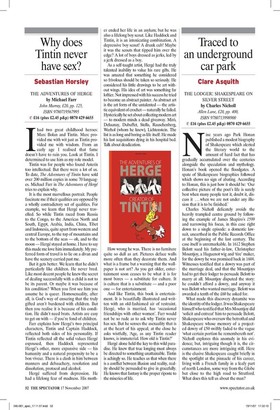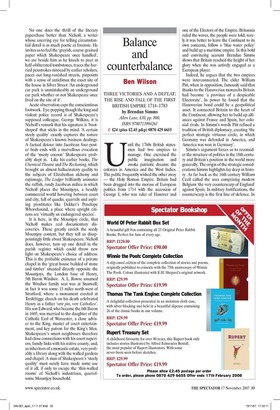Traced to an underground car park
Clare Asquith THE LODGER: SHAKESPEARE ON SILVER STREET by Charles Nicholl Allen Lane, £20, pp. 400, ISBN 9780713998900 £16 (plus £2.45 p&p) 0870 429 6655 Nine years ago Park Honan published a modest biography of Shakespeare which alerted the literary world to the amount of hard fact that has gradually accumulated over the centuries alongside the speculation and mythology. Honan's book opened the floodgates. A spate of Shakespeare biographies followed which shows no sign of abating. According to Honan, this is just how it should be: 'Our collective picture of the poet's life is surely best when many people test it, doubt it, discuss it ... when we are not under any illusion that it is to be finished.'
Charles Nicholl delicately avoids the heavily trampled centre ground by following the example of James Shapiro's 1599 and narrowing his focus, in this case right down to a single episode: a domestic lawsuit, unearthed in the Public Records Office at the beginning of the last century. The case itself is unremarkable. In 1612 Stephen Belott sued his father-in-law, Christopher Mountjoy, a Huguenot wig and `tire' maker, for the dowry he was promised back in 1604. Witnesses testified that a dowry was part of the marriage deal, and that the Mountjoys had to get their lodger to persuade Belott to marry at all. Mountjoy disputed the story: he couldn't afford a dowry, and anyway it was Belott who wanted marriage. Belott was awarded a tenth of the £60 he asked for.
What made this discovery dynamite was the identity of the lodger. It was Shakespeare himself who testified that Mrs Mountjoy did 'solicit and entreat' him to persuade Belott, Shakespeare who oversaw the betrothal and Shakespeare whose memory of a projected dowry of £50 swiftly faded to the vague 'what certain portion he remembereth not'. Nicholl explores this anomaly in his evidence; but, intriguing though it is, the circumstances are more intriguing still. Here is the elusive Shakespeare caught briefly in the spotlight at the pinnacle of his career, living with a French family in a leafy part of north London, some way from the Globe but close to the high road to Stratford. What does this tell us about the man?
No one does the thrill of the literary paperchase better than Nicholl, a writer whose unerring eye for telling circumstantial detail is as much poetic as forensic. He invites us to feel the 'greyish, coarse-grained paper which Shakespeare once handled', we are beside him as he kneels to peer at half-obliterated tombstones, traces the hurried penstrokes misread by earlier scholars, paces out long-vanished streets, pinpoints with a sense of anticlimax the exact site of the house in Silver Street: 'An underground car park is unmistakeably an underground car park whether or not Shakespeare once lived on the site of it'.
Acute observation caps the conscientious footwork. Eye-popping though the long and violent police record is of Shakespeare's supposed colleague, George Wilkins, it is Nicholl's remark that his signature is 'bootshaped' that sticks in the mind. 'A certain steely quality' exactly captures the nature of Shakespeare's known business dealings. A factual detour into Jacobean four-poster beds ends with a marvellous evocation of the 'musty cocoon' Shakespeare probably slept in. Like his earlier books, The Chemical Theatre and The Reckoning, which brought an almost hallucinatory quality to the subjects of Elizabethan alchemy and espionage, The Lodger brilliantly animates the raffish, randy Jacobean milieu in which Nicholl places the Mountjoys, a beadily commercial world hovering between court and city, full of quacks, quarrels and aspiring prostitutes like Dekker's Penelope Whorehound, a place where upright citizens are 'virtually an endangered species'.
It is here, in the Mountjoy circle, that Nicholl makes real documentary discoveries. These greatly enrich the seedy Mountjoy context, but they tell us disappointingly little about Shakespeare. Nicholl does, however, turn up one detail in the parish register which could throw new light on Shakespeare's choice of address. This is the probable existence of a private chapel in the 'great house builded of stone and timber' situated directly opposite the Mountjoys, the London base of Henry, 5th Baron Windsor. A. L. Rowse assumed the Windsor family seat was at Stanwell; in fact it was some 15 miles north-west of Stratford, where a monument erected at Tardebigge church on his death celebrated Henry as a father `vere pio, vere Catholico' His son Edward, who became the 6th Baron in 1605, was married to the daughter of the Catholic Earl of Worcester, a close adviser to the King, master of court entertainment, and key patron for the King's Men. Shakespeare's smart neighbours therefore had close connections with his court superiors, family links with his native county, and, as inheritors of a monastic estate, very probably a library along with the walled gardens and chapel. A man of Shakespeare's 'steely quality' must surely have made some use of it all, if only to escape the 'thin-walled rooms' of Nicholl's industrious, quarrelsome Mountjoy household.





































































 Previous page
Previous page